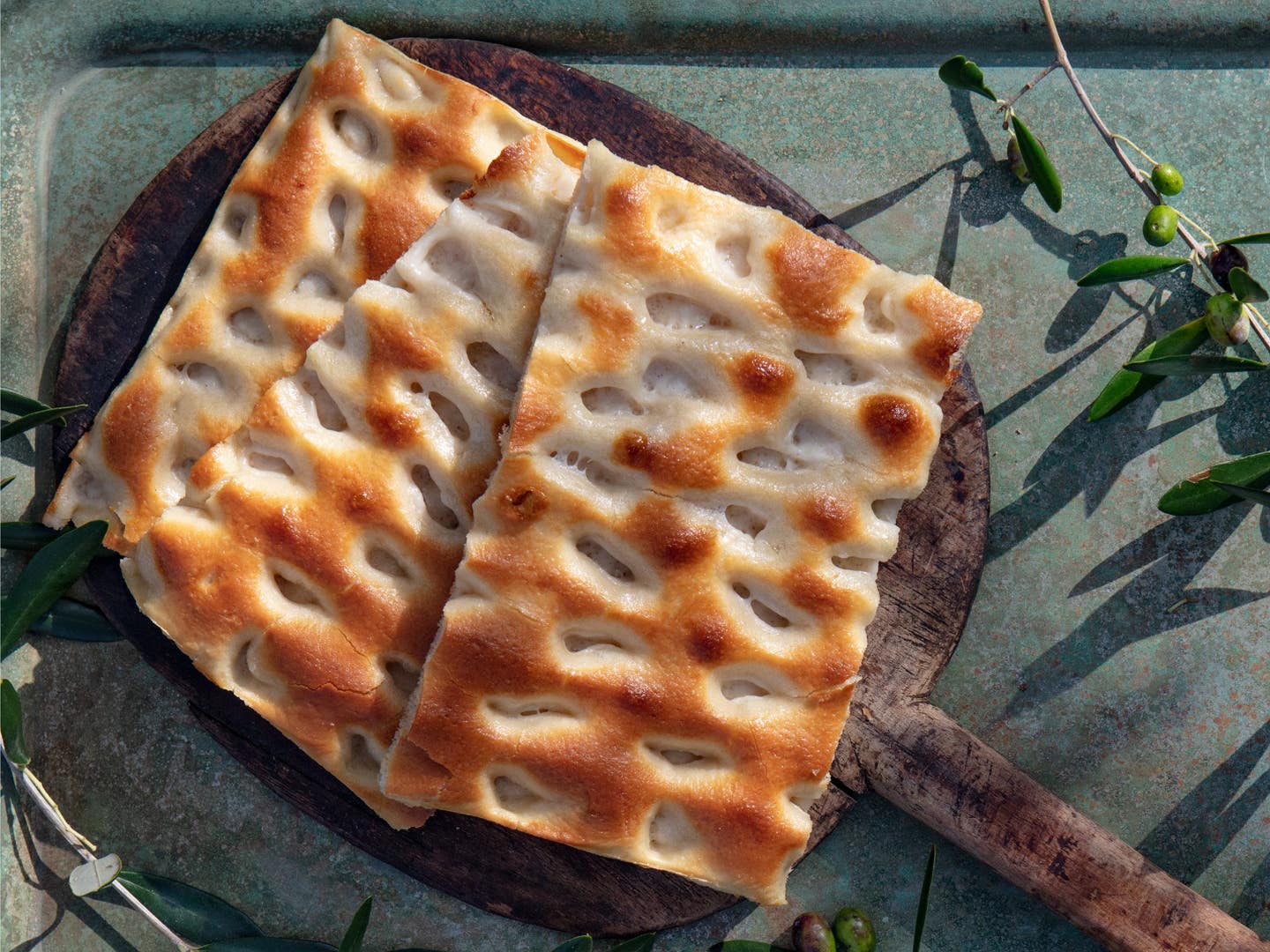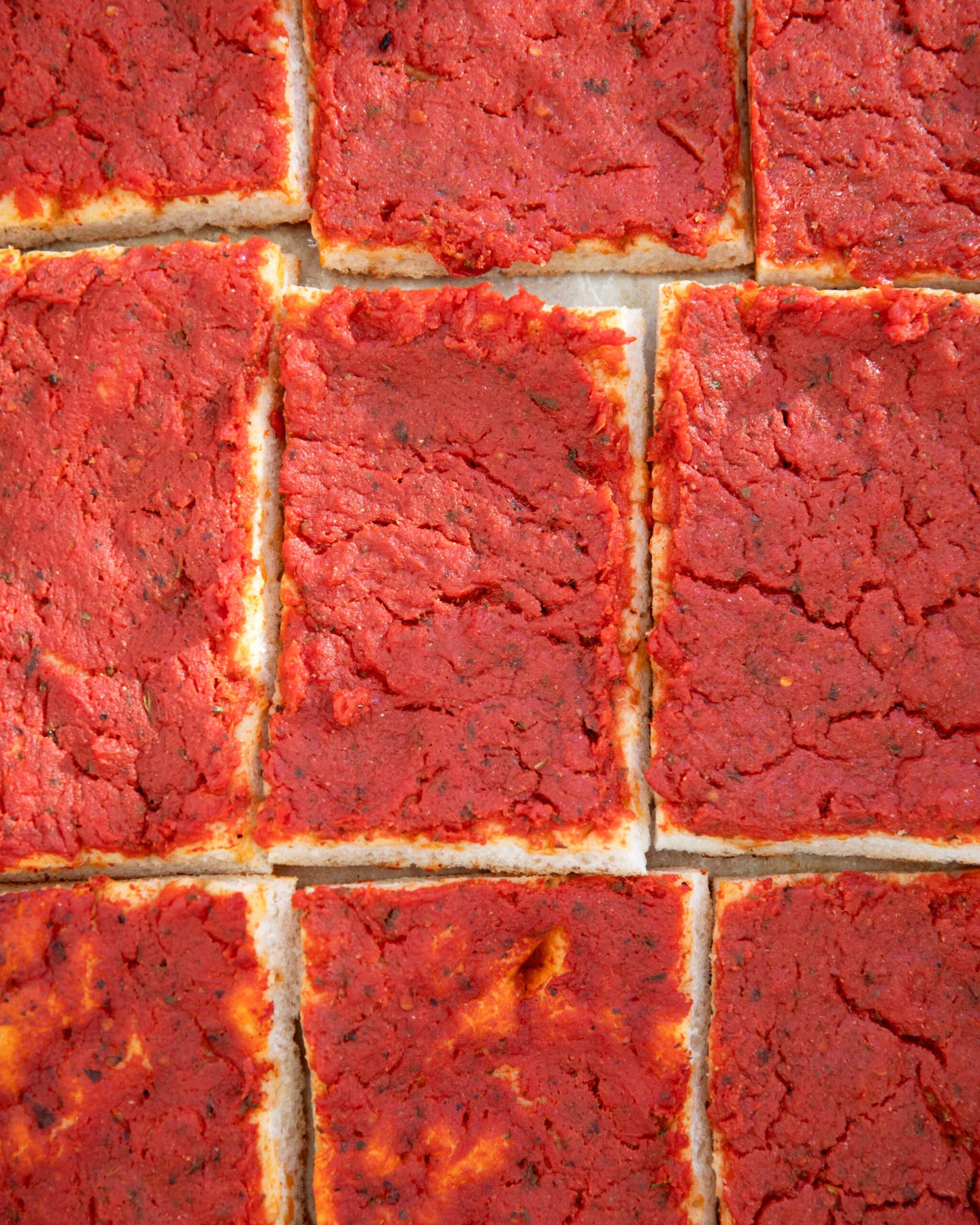Ligurian Focaccia (Fügassa)
In the birthplace of the beloved Italian flatbread, this rich and unadorned loaf is an institution, a birthright, and a ritual.
- Serves
makes two 10½ by 15½ -inch loaves
- Time
17 hours

The first time I tasted real Ligurian focaccia (fügassa in local dialect) was my first day in Genoa and my first ever trip to Italy. After a whirlwind, three-week romance in Texas, I flew halfway across the world with my future husband to visit his hometown. Our first stop, naturally, was the neighborhood forno. The focaccia offerings enchanted me: olive-studded, sage-filled, or onion-topped, I wanted to try them all. Emilio ordered a sampling, and we sat on a green park bench in a nearby piazza to eat. I dove straight for the olive-topped version, but he stopped me, slipping a plain slice into my hands instead. “You must try the classic focaccia first. This is where everything begins.”
To unravel the immensely complex world of fügassa, I contacted Ezio Rocchi, also known as “the king of focaccia,” who comes from a long line of Genovese bakers. Amongst the precious gems of knowledge he bestowed upon me (many of which found their way into the following recipe), he let me in on a secret for eating focaccia: “If you watch closely, you’ll notice the Genovese eat their slice upside down,” he grinned, “that way, the tongue comes directly in contact with the salty upper surface, and the flavor is more intense.” I’ve included some variations and toppings in my book, Liguria: The Cookbook, but you should really try your hand at the classic recipe first. After all, it’s where everything begins.
Be sure to use the best-quality, mild-tasting extra-virgin olive oil you can find; a bitter oil can ruin the entire batch.
Featured in: “Liguria Author Laurel Evans Makes a Damn Good Pesto.”
This recipe is adapted from Laurel Evans’ book, Liguria: The Cookbook.
Ingredients
For the sponge:
- ¼ tsp. (1 g) active dry yeast
- 1 cup (127 g) bread flour
For the dough:
- 2¼ tsp. (10 g) active dry yeast
- 3¾ cups (485 g) all-purpose flour, plus more for dusting
- 1 tbsp. (14 g) sugar
- 1½ tsp. (6 g) kosher salt
- 1 cup 3 Tbsp. cold water, divided
- ½ cups plus 2 Tbsp. plus 1½ tsp. extra-virgin olive oil, divided, plus more for brushing
For the brine:
- 1¾ tsp. salt
Instructions
Step 1
Step 2
Step 3
Step 4
Step 5
Step 6
Step 7
Step 8
Step 9
Step 10
Step 11
Step 12
- The night before you plan to bake, make the sponge: Prepare the sponge: In a medium bowl stir together ¼ cup lukewarm water and the yeast. Add the flour and knead briefly by hand just until a shaggy dough forms. Transfer to a pint jar or plastic deli container (the sponge should touch the sides and have a little room to grow vertically.) Cover with plastic wrap or a lid and set aside at room temperature until the sponge is slightly puffed, 12–14 hours.
- The following morning, make the dough: In a small bowl, dissolve the yeast in 2 tablespoons of lukewarm water. To the bowl of a stand mixer fitted with a hook attachment, add the reserved sponge, the flour, sugar, salt, and 1 cup plus 2 tablespoons cold water. Mix on low speed until a shaggy mass forms, about 2 minutes, then turn the mixer up to medium speed and continue mixing until the dough is smooth and firm, 5–7 minutes. Turn the mixer off and set aside to rest until the dough is slightly relaxed, 10–15 minutes.
- Add 2 tablespoons plus 1½ teaspoons of the olive oil and the reserved yeast mixture and mix on the liquids are incorporated and the the dough can be stretched without pulling back, about 5 minutes. Add 1 tablespoon cold water and continue mixing until the dough is smooth and elastic, 5 to 10 more minutes.
- Lightly flour a clean work surface and turn the dough out onto it. Using a bench scraper or large knife, divide the dough in half. Slightly stretch and flatten one portion into an oblong shape, then fold into thirds, like folding a letter. Rotate the dough 90 degrees, stretch, and fold into thirds again. Gently stretch the dough into a rounded brick shape and set aside, seam-side down. Repeat with the second half of the dough. Lightly flour the tops of the two loaves, then cover with a clean, dry kitchen towel or plastic wrap. Set aside to rest at room temperature until doubled in size, about 30 minutes.
- Prepare the pans: Into two 10½- by 15½-inch rimmed baking sheets, divide the ¼ cup of olive oil; using your fingers, spread the oil all over to grease the bottoms of the sheets, leaving a 2-inch ungreased border around the edges. Set aside.
- Using a lightly floured rolling pin, gently roll out each portion of the dough dough to a thickness of ½ inch. Transfer each piece to one of the oiled baking sheets. (The dough will not fill up the entire sheet at this point.) Cover the sheets with clean, dry kitchen towels or plastic wrap and set aside to rise in a draft-free place until the dough is slightly puffed, 20–25 minutes.
- Uncover the focaccia and dust the surfaces lightly with flour. Gently stretch the dough to the ungreased edges of the baking sheets. (If you pull a corner and the dough springs back, re-cover and let it rest another 15–25 minutes until it holds its shape when stretched.) Press the dough into the edges of the pan with your fingertips, creating a seal so that the brine won’t seep under later.
- Cover and set aside to rise until the dough is very soft and nearly doubled in size, 60–75 minutes.
- Meanwhile, make the brine: In a small bowl, stir together 1 cup hot water and the salt to dissolve, then set aside.
- Uncover the dough and test it with your finger; if it springs back when you make a firm indentation, it is not ready yet. Re-cover and let proof a little longer until the indentation remains when firmly pressed. When risen, lightly flour the surfaces. Place one of the sheets on the table in front of you with the short side closest to you. Hold your index, middle, and ring fingers at a 45 degree to the pan and, starting at the top-left side of the tray, press the pads of your fingers firmly into the dough, shifting them very slightly forward and backward to make elongated dimples. Lift your fingers and move down to create another 3 dimples about ½ inch below the first row. Work your way down the left side of the pan, stopping a few inches from the bottom. Repeat until the entire tray is dimpled, then rotate 180 degrees in order to dimple the bottom edge. Repeat with the other tray of focaccia. Pour half of the brine evenly over each sheet of dough, then drizzle each with 2 tablespoons of olive oil. (The brine will seem like way too much but have faith! It should fill all of the dimples.) Set aside, uncovered, until the dough is very soft and airy, 40–45 minutes.
- Meanwhile, preheat the oven to 450°F; position one of the oven racks in the upper third and another in the lower third.
- When the oven is hot, bake the focaccia, rotating the trays between the top and bottom racks once halfway through baking, until the tops are golden but the dimples are still light beige, 18–22 minutes. Remove from the oven and immediately brush liberally with olive oil. Using a thin metal spatula or bench scraper to loosen the edges, remove the focaccia from the baking sheets immediately. Transfer to a wire rack or cool upside down, so the bottoms don’t get soggy. Cut into slices and serve warm.
Keep Reading
Continue to Next Story










